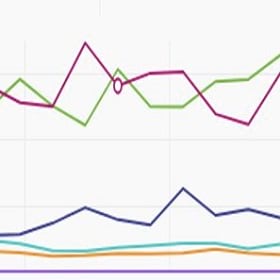As the postpandemic economy lurches toward recovery, HR leaders and hiring managers face a radically different labor landscape. Many are discovering a contrarian reality: in a labor force that’s never been more remote from the office, geography has never mattered so much, and workforce analysis must evolve to keep pace.
The widespread implementation of remote working spurred by the health crisis appears to have transformed workplace culture permanently. Companies like Facebook, Twitter, and Slack have vowed to allow employees to telecommute permanently. Cushman & Wakefield CEO Brett White told CNBC that he expects fully remote workers to make up as much as 12 percent of the workforce postpandemic, up from 5 percent a year ago.
And many workers prefer this arrangement. According to a McKinsey report, 80 percent of survey participants said they enjoy working from home, and 41 percent said they’re more productive than ever.
Other recent shifts have been similarly disruptive. Personnel executives in fields like hospitality, retail, and air travel have had to furlough or lay off thousands, while their counterparts in fields like health care and tech have been hiring aggressively, as demand for positions like long-term care nurses and security software experts rises sharply. An estimated 17 million American workers—that is, 1 out of every 10—will likely have to leave their jobs and shift to new occupations by 2030 as a result of COVID-19’s economic impact.
To navigate these historic reconfigurations of the US labor force, HR executives and hiring managers are collaborating with colleagues in data analytics and rethinking workforce analysis. Pre-pandemic, one of the world’s largest e-commerce retailers and one of its best-known asset managers used geographic information system (GIS) technology to gauge the characteristics of regional labor markets when performing site selection for new locations.
Now the business insight generated by GIS, known as location intelligence, is helping to shape workforce analysis of the future—with a greater focus on finding overlooked talent, including workers of color. Smart maps are fueling innovative approaches to fill out company ranks with the best talent, while making sense of emerging geographic and demographic patterns that some companies may only dimly sense.

HR executives expect spending on workforce planning and strategy to increase more than other categories in the next year, making it an even higher priority than recruiting or learning and development.
The Future of Workforce Analysis
Remote working is poised to invert how companies have traditionally found talent. In the past, a company looking to open an office might analyze the labor markets and commute times in a handful of metro areas to determine the best location.
Now, to find top workers made newly mobile by telecommuting, a talent acquisition VP or line-of-business manager can use location analysis to conduct a national search, using data on occupation, income, and other metrics to zero in on promising pockets of talent. The company could then concentrate recruiting and job marketing efforts in those areas, and offer desirable candidates the ability to work from home.
This new approach to workforce planning could have breakthrough potential in helping businesses hire more diverse and inclusive staffs. For instance, according to a Brookings Institute analysis, Black workers constitute just over 4 percent of the computer and math workforce in the San Diego-Carlsbad, California, metro area, versus 21 percent in Beaumont-Port Arthur, Texas. Tech companies headquartered in high-growth but predominately white regions like Seattle or Provo, Utah, could concentrate recruitment and marketing efforts for remote positions in Black neighborhoods in the South with rich labor pools that have been overlooked and untapped.
A number of creative solutions are also afoot to rebalance payrolls transformed by pandemic fallout. Executives seeking to move people with transferable skills from areas of low occupational demand to areas where it has soared could employ GIS-powered dashboards to identify job markets with the highest potential for reskilling. In some cases, those jobs will be remote; in others, they’ll be tied to a workplace. In either case, geography plays a significant role in understanding the possibilities.
As reported in the Wall Street Journal, CVS has set up hiring alliances with more than 60 US employers like Hilton and Gap, turning layoffs at those companies into a labor force for the pharmacy chain as it sought to hire over 100,000 workers. Similarly, Amazon has recruited tens of thousands of employees from partners like Uber and United Airlines to meet supercharged e-commerce sales as demand for ride-sharing and air travel has dropped.
Location intelligence can guide innovative matchmaking efforts like these by revealing critical demographic information, including which sections of a regional labor pool have the right mix of skills, certifications, and aptitude to shift to an adjacent occupation. Smart maps can support long-term planning by pointing a company toward workforce development partnerships that will open talent pipelines in areas where business is expected to increase.
Whether the post-COVID-19 economy resembles the Roaring Twenties or a slower, more complicated recovery, the kind of agility and analytic savvy made possible by GIS will guide many workforce decisions.
“I Would Go to Texas”
Business executives will also want to follow talent flows or migrations—what data scientists call “human weather“—as they perform location-aware workforce planning.
Consider the recent woes of California’s tech industry. In the past two years, leading businesses—including Oracle, Hewlett-Packard, Tesla, and Charles Schwab—announced they would be leaving the Golden State and relocating their headquarters in Texas, citing burdensome taxes and regulations. California also saw its third-largest migration loss ever in 2020, with over 135,000 more people leaving the state than moving in.
In a recent Q&A, John Chambers, the former Cisco CEO and elder statesman of Silicon Valley, told Protocol: “If I were doing a startup today, I would go to Texas.”
The Bay Area remains the preeminent global hub of digital innovation, and it’s San Francisco’s title to lose. Yet this wave of exits could signal a dispersal of the tech and entrepreneurial talent that made Silicon Valley the cutting edge of disruption. Tech workers are already flooding into so-called Zoom towns—low-cost gateway communities affording skiing, kayaking, and hiking. Texas, Idaho, Florida, and even Montana are popping up on the national radar as fertile startup seedbeds.
Workforce dynamics in other industries have also been volatile, with new pressures and new opportunities arising in distinct geographic areas.
Remote Possibilities Become Real
Companies looking to hire the hottest app designers and creative minds need tools like GIS to plot human movement data and follow the talent where it goes. Labor analysis firm Chmura has shown that it’s possible to map all of the country’s metropolitan statistical areas (MSAs) by a remote-working index, indicating areas with the highest ratios of remote employees.
Predictably, a smart map of this analysis shows that these clusters appear in cities in the Northeast and the Pacific Northwest. But smaller pockets like Huntsville, Alabama, and Tallahassee, Florida, also stand out. A consulting firm looking to fill office-optional positions could use GIS to home in on these pockets, while analyzing local job posting data to determine the competitiveness of the hiring market. Similarly, a coastal ag tech company could recruit midwestern graduates from schools like Purdue and the University of Illinois, drawing on talent that often stays close to home.
An acute grasp of the geographic spread of skills may also prove crucial to fixing racial disparities in hiring. As a recent report on race in the workplace found, nearly 60 percent of the Black labor force in the US resides in the South, while areas poised for growth over the next couple of years, like Seattle, have a much smaller Black population. Chmura data also shows that while Blacks account for nearly 13 percent of the labor force, just 7 percent of workers in remote-work occupations are Black.
“Companies may require more sophisticated data than they’ve used in the past to identify: ‘Where are the workers that we’re trying to hire to have more diversity within our own workforce?'” says Chris Chmura, the firm’s CEO and chief economist. “If they allow more remote working, they can look across the country and find concentrations of software developers they want to hire, and recruit from those areas.”
Turning Job Losses Into Gains
The roller coaster of the pandemic year not only has changed where workers are and how companies find them, it also has fundamentally changed which professions are in high demand, and which sectors have seen hiring dry up.
Most of us can intuit the general direction of these shifts: bars, gyms, and various types of retail face steep losses, while grocery stores, hospitals, and e-commerce companies can’t hire fast enough. Some stores no longer need cashiers or sales floor representatives, but do require workers to staff dark stores, warehouses, fulfillment centers, and supply chains that support robust online shopping.
In some cases, the very same type of worker is being shed from one industry and demanded in another. Hotels and motels are letting go of janitors and cleaners, while home improvement stores and medical facilities need these same skilled workers to sterilize high-use spaces.
Across industries and companies, innovative labor solutions like the ones employed by CVS and Amazon are under way to pair workers with in-demand positions. These strategies require an understanding of skills that goes beyond mere job titles, and can benefit from location analysis.
Uncovering Skill Set Clues with GIS
Location intelligence can aid such efforts to cross-train or reposition employees by providing a nuanced picture of a workforce in a given region. An HR executive looking for telehealth professionals could map labor data from a specific region or city on a GIS-powered dashboard.
That could yield a geographic view not just of the specialists in that field but health-care professionals in adjoining industries or with similar skill sets, along with their average incomes and the turnover rates in the area. That information could help the executive understand what incentives might be necessary to attract a good candidate to the position that needs to be filled.
Location-enabled workforce analysis can layer in more advanced metrics like psychographic profiles or lifestyle tendencies that show up in hobbies. Imagine a firm looking to hire security professionals to work with dogs in high-risk scenarios. Using demographic segmentation, a GIS analyst could identify promising labor pools by cross-layering county data on military service with the number of tags purchased for upland bird hunting—a pastime involving hours of dog training. In the wake of the pandemic, the same technique could be used to uncover prospective hires for AI or health-care robotics that more rudimentary hiring searches might miss.
In some cases, a company may apply location analysis as a long-term planning tool. A business may be opening a new fulfillment warehouse or data center in a market that offers every advantage except a built-in workforce. Company leaders could work with community centers, local schools, and trade boards to build a talent pipeline and boost the needed job training. GIS can help executives understand existing opportunities and community needs, and how they relate to the new location’s labor profile. Companies like Chick-fil-A cultivate partnerships like these with universities to meet hiring demand for graduates who are savvy in both supply chain logistics and location intelligence.
HR in the Spotlight
Outside the Fortune 100, workforce analysis has sometimes been treated as little more than an exercise in head count or compensation distribution. The complex labor puzzle presented by the pandemic—and the changed workplace it will leave behind—has elevated the role of effective workforce planning. In the coming months, CEOs will lean heavily on HR executives to shape an effective workforce strategy. They in turn will increasingly rely on analysts and tools like GIS to assemble the teams best able to rebuild the post-COVID-19 economy.
The Esri Brief
Trending insights from WhereNext and other leading publicationsTrending articles

December 5, 2024 |

November 12, 2018 |

July 25, 2023 |

February 1, 2022 |

March 18, 2025 |

May 28, 2025 |





